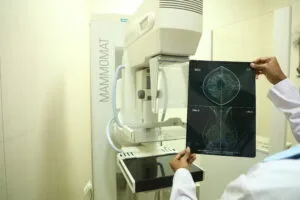The importance of Mammogram

The importance of Mammogram
Breast cancer (BC) is the most common malignancy among women worldwide, surpassing lung cancer as the leading cause of global cancer incidence in 2020, with an estimated 2.3 million new cases, representing 11.7% of all cancer cases. Epidemiological studies predict that the global burden of BC will exceed 2 million cases by 2030. In India, the incidence of breast cancer has risen significantly, nearly doubling between 1965 and 1985. In 2016, India had an estimated 118,000 new cases (95% uncertainty interval: 107,000 to 130,000), with 98.1% of these being female, and there were 526,000 prevalent cases (474,000 to 574,000). Over the past 26 years, the age-standardized incidence rate of BC in Indian women has increased by 39.1% (95% uncertainty interval: 5.1 to 85.5) from 1990 to 2016, with this increase observed in every state. According to Globocan data from 2020, BC in India accounted for 13.5% (178,361) of all cancer cases and 10.6% (90,408) of all cancer deaths, with a cumulative risk of 2.81.
- What is a mammogram test?
A mammogram test is an X-ray examination of the breast used to detect and diagnose breast disease. It is utilized for women experiencing breast problems like lumps, pain, or nipple discharge, as well as for those with no symptoms. This procedure can identify breast cancers, benign tumors, and cysts before they are detectable by touch.
- How are screening and diagnostic mammograms different?
Both screening and diagnostic mammograms use the same machines. However, diagnostic mammography takes longer and involves a higher total dose of radiation, as it requires more X-ray images to capture multiple angles of the breast. The technologist may also magnify a suspicious area to produce a detailed image, aiding the doctor in making an accurate diagnosis.
- What are the reasons of getting mammogram?
Screening mammograms are generally recommended for:
1. Women aged 40 and older: Many guidelines suggest beginning annual or biennial screening at age 40, although some organizations recommend starting at age 50.
2. Women with a family history of breast cancer: Those with close relatives who have had breast cancer may need to start screening earlier and possibly more frequently.
3. Women with genetic predispositions: Individuals with BRCA1 or BRCA2 gene mutations, or other genetic factors, may require earlier and more frequent screenings.
4. Women with previous breast cancer or abnormal biopsy results: Those who have had breast cancer or certain types of abnormal biopsy results may need more frequent monitoring.
5. Women with dense breast tissue may be advised to undergo additional or earlier screenings due to the challenges dense tissue poses in detecting cancer with mammograms.
6. Women with other risk factors: This includes factors like a history of radiation treatment to the chest, certain hormone replacement therapies, or other conditions that increase breast cancer risk.
It’s essential for individuals to discuss their specific risk factors and screening schedule with their healthcare provider.
- Can mammograms detect cancer?
Mammograms are crucial for detecting abnormal breast tissue, but they cannot definitively diagnose cancer. They can reveal suspicious areas, prompting healthcare providers to recommend further testing, such as a breast biopsy. A biopsy is necessary to determine if the tissue is cancerous or noncancerous.
- Who performs mammogram test?
A mammogram is performed by a healthcare professional known as a radiology technologist or mammographer, who has specialized training to ensure the procedure is conducted safely and accurately. The images obtained are then reviewed and interpreted by a board-certified radiologist, an expert in analyzing mammograms. The radiologist forwards the results to your healthcare provider, who will then review and discuss them with you.
- What is the procedure for mammogram?
A mammogram uses a specialized X-ray machine designed exclusively for examining breast tissue, operating at lower doses than those used for bone X-rays.
During the procedure, you place your breast on a support plate connected to the machine. A technologist then compresses your breast with a parallel plate called a paddle. The machine emits X-rays that pass through your breast to a detector on the opposite side, which transmits electronic signals to a computer to create a digital image, known as a mammogram.
Breast compression is essential to keep your breast still, reducing movement that could blur the X-rays. It also flattens the breast tissue, allowing the X-rays to travel a shorter distance to the detector. This reduces the radiation dose and improves image quality.
- Is mammogram painful?
Undergoing a mammogram can be uncomfortable due to the pressure from breast compression, and it may be painful for some individuals. Fortunately, the procedure is brief, and any discomfort is short-lived. If you experience intense pain, notify the technologist immediately.
Discomfort levels can vary depending on factors such:
– Size and density of your breasts.
– The degree of compression needed
– Sensitivity due to menstrual cycle timing (such as being about to get or being on your period)
– The skill of the radiology technologist
– Your ability to relax and position yourself optimally for clear images.
- What if my mammogram is abnormal, what should I do next?
If a mammogram reveals an abnormal area in the breast, your doctor will order additional tests to obtain clearer and more detailed images.
While most lumps are non-cancerous, further tests such as an ultrasound or MRI are necessary to confirm this. If these tests indicate that the mass is solid, your radiologist may recommend a biopsy. During a biopsy, cells are taken from the suspicious area to determine if cancer is present.
- What other technologies or strategies are being developed for breast cancer screening?
The National Cancer Institute (NCI) is supporting the development of various new technologies for detecting breast tumours. This research encompasses methods in both laboratory development and clinical trials. Efforts to enhance conventional mammography include advancements such as digital mammography, magnetic resonance imaging (MRI), positron emission tomography (PET) scanning, and diffuse optical tomography, which uses light instead of X-rays to create breast images.
- Are there any risks associated with screening for mammogram?
Mammography uses x-rays to create breast images, exposing patients to a small amount of ionizing radiation. While this radiation carries some risk, for most women, the benefits of regular mammograms outweigh this potential harm. Younger women under age 40 may face slightly higher risks from radiation exposure. However, in certain situations, the benefits of early breast cancer detection through mammography can justify this risk. For instance, a mammogram can confirm a suspicious mass as benign, avoiding unnecessary treatment. Alternatively, detecting a malignant tumor early may allow for less invasive treatment options, potentially avoiding the need for aggressive therapies like chemotherapy.
Conclusion: A mammogram is a crucial tool in breast cancer screening and detection. It allows healthcare providers to detect abnormalities in breast tissue, such as tumors or microcalcifications, often before they can be felt. Regular mammograms can significantly increase the chances of detecting breast cancer early, when treatment is most effective.
However, mammograms are not infallible. False positives (indicating cancer when there is none) and false negatives (missing cancer that is present) can occur. Additionally, mammograms expose women to a small amount of radiation, though the benefits of early detection typically outweigh this risk.
Ultimately, the decision to undergo mammography should be made in consultation with a healthcare provider, considering factors such as age, family history, and overall health. For many women, regular mammograms are a valuable part of maintaining breast health and catching cancer early if it develops.



